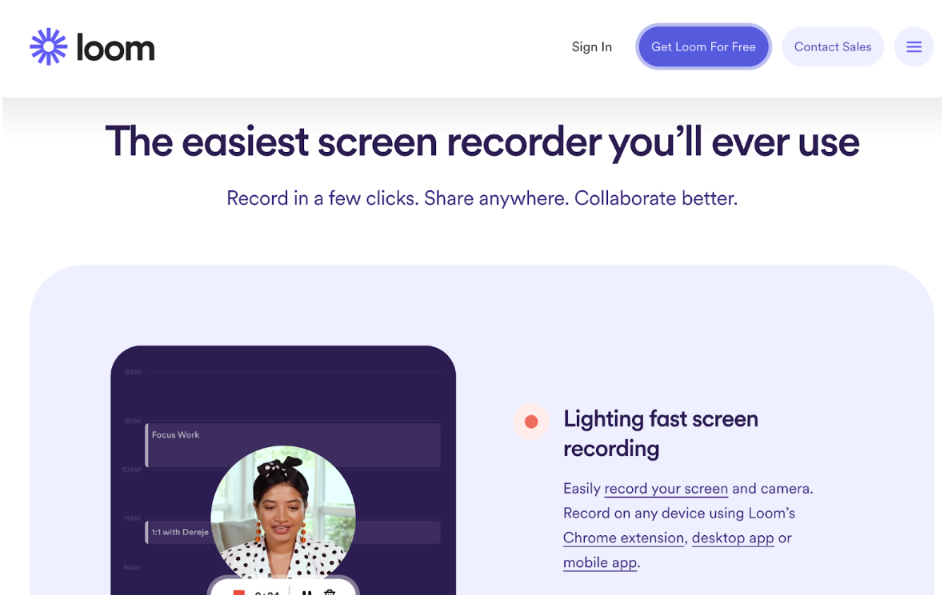Nobody wants to hear crickets when they’re trying to grow sales. We all want a consistent, growing pipeline of deals and opportunities. And there’s only one way to do that: our ability to win new customers. That brings us to sales prospecting.
Sales prospecting helps us:
Find the right people…
at the right time…
so we can close the sale.
In this article, we’ll define sales prospecting, ways to improve it, and some of the best sales tools to upgrade your strategy.
What is sales prospecting?
Sales prospecting is identifying and communicating with potential customers. The goal is to create an efficient pipeline for new business so you can grow your revenue.
Looking at alternate uses of the word “prospecting” helps make sense of the term. In geological prospecting, for example, people search through thousands of minerals, items, and land to find valuable metals.
Similarly, sales teams select a specific group of people who need solutions. They search for qualified candidates by focusing on different target audience segments, the stage in their buyer's journey, and their pressing needs. As you can imagine, that takes some serious strategy, processes, and tools to accomplish (keep reading for an optimized solution).
Your sales cycle starts with efficient and accurate prospecting.
The first step to prospecting is identifying your target audience.
Salespeople must find the right prospects interested in your solution. To do that, they should consider each customer's spot on the buyer’s journey. It determines how qualified they are and what timeline you can expect for closing sales.
Once you know who to target, you need their contact information.
The process starts with a way to communicate your offer. That can look like sending a direct message on LinkedIn to potential clients, creating a lead magnet to capture emails from future customers, or using an email template to reach targeted prospects.
When you contact prospects, there are dozens of ways to connect.
With technology like Loom, you can achieve immersive communication through personalized videos.
By now, your sales reps have had time to evaluate and qualify their contacts.
Salespeople continue to nurture the relationship with prospects. They look for a genuine interest in purchasing or solving their needs. The sales team follows up, provides relevant information, and answers questions.
When prospects intend to make a purchasing decision (or you arrive at a benchmark in your process), your sales team can work on closing the sale.
Why is sales prospecting difficult?
Sales prospecting is challenging, no matter your company size. It’s difficult for the following reasons:
It’s not easy to find the right leads at the right time
It’s hard to manage many moving pieces during initial communication to closing a sale
Even if prospects need your solution, they’re hard to reach
Companies can solve these issues by nurturing leads and leaning into self-service buying. Teams can improve their outbound prospecting with digital assets that answer relevant questions and cover use cases.
Why sales prospecting matters now more than ever
It’s no secret: capturing attention is harder than ever. Sales professionals aren’t competing in their main industry anymore. They’re competing with the news, social media, and streaming apps. And that’s not all.
You’re also competing with a shrinking attention span. CNN Health reports that in the last twenty years, attention spans went from 2.5 minutes to 75 seconds to 47 seconds. Thankfully, it’s not all doom and gloom. There’s good news.
Teams can connect with prospects with a more effective sales strategy. For example, take companies meeting customer demand for self-service buying.
This trend is a precursor to a broader trend of consumers wanting to walk the customer journey on their terms. We first noticed self-service buying in retail and food spaces. The next time you’re at a quick service restaurant, you might order from a screen or phone. Or, you might do a self-checkout at the supermarket.
Today, self-service buying is alive and well in the digital arena—especially in B2B sales. The demand is startling, with TrustRadius reporting that “virtually 100%” of B2B buyers prefer to self-serve their buyer’s journey (it increased by 13% in one year). This is a considerable advantage for companies aligning themselves with prospect demand.
Use case: Someone interested in a SaaS or solving a certain problem will search for answers online. They might read your content and go through the sales funnel until they decide to buy from you. Or you might have various videos, illustrations, and other resources to help prospects decide.
Benefits of sales prospecting techniques
Every company does sales prospecting whether they know it or not. However, a healthy prospecting strategy adds significant advantages.
Pipeline of future customers: As a company, you can rely on consistent sales and revenue with an effective sales pipeline of new customers. You can also measure your rate of growth and plan to scale.
Tight feedback loop: As you interact with more prospects, you’ll deal with many positive responses and hesitations. You can use these responses and feedback to improve your strategy.
Your company can focus on the product and future: Once you have a successful sales prospecting system, you can shift more time to improving your product and growing your business.
Increased sales: With more customers comes more revenue. Your company can grow with the additional income produced by your improved prospecting.
Fruitful outreach: 6 Ways to improve your sales prospecting strategy
Before modern tools like Loom, sales prospecting was inefficient. It was all about reaching mass numbers, impersonal and costly. Whether that was cold calling from a long list, cold emailing, or dumping boxes of direct mail down the shoot, it was a numbers game, and we hoped for the best.
Technology has now changed the way we reach new prospects and increase conversion. For one, people want personalization. If we can address the prospect’s needs and answer their exact questions within their context, we are more likely to land the sale.
Use these sales prospecting tips to improve the buying process with new leads.
1. Meet them where they are
It’s always a good idea to find the platforms and locations where your audience likes to hang out. Additionally, find out how they prefer to be contacted. Depending on their demographics (like age), they might prefer an email, phone call, or DM.
That’s why it’s essential to talk on the same level as your prospects so you can connect with them. You can do that by defining your ideal customer profile and creating a strategy to close deals.
Tools like Loom offer versatile and creative ways to reach your prospects. Since it’s as easy as recording and sharing with a link, you can send highly relevant content to your sales leads on the platform they like best.
2. Publish consistent value so they reach out to you
Great prospecting should be combined with inbound marketing. Sales teams can publish digital assets, articles, and videos. They can hold webinars and workshops to add value to prospects and build rapport.
If you haven’t reached out to potential buyers yet, there’s a chance they’ll come to you first. Your content serves as lead generation. This is one way to scale your prospecting strategy beyond time-consuming tactics.
Loom empowers salespeople to record themselves and their products so prospects can get a front-row seat to solutions.
3. Create a video catalog of common questions
In the age of digital self-service, it’s important to give prospects the tools to start their customer journey. Teams can build a catalog of highly relevant videos to common customer questions. Whether it’s a step-by-step demo or use case examples, every piece of content helps prospects with their individual journey.
Loom allows teams to build videos for the most pressing questions easily and quickly. It also saves sales teams time while warming up leads simultaneously.
4. Develop a robust blog strategy
Your company can also create discoverable and helpful content on its website. Each page can include a Loom video while your article compliments the ideas. You can also include other Loom videos throughout the article to clarify certain points. These blog articles serve as an easy one-stop resource for prospects. If those leads answer to decision-makers, giving them shareable resources makes their job much easier.
5. Ask for referrals
One of the most cost-effective ways to win new business is through referrals. After making a customer happy, ask them if anyone else may need your solution. There’s nothing more human than a person wanting to help someone in a similar situation. Those contacts and the rapport you have with the customer who shared them with you will help you close more deals faster.
Using Loom, you can easily equip your customer with relevant assets. If that customer connects you with their friend, you can provide resources that showcase your product. It can tackle pain points and common hesitations.
6. Follow up with helpful value
As you nurture your relationships, always give them value. You can do so by quickly and effectively answering questions. Salespeople can record original videos that answer personalized questions by the prospect. That custom experience will help address concerns more accurately. It wins prospects over with the attention and care you’ve put into them.
Sales prospecting software and tools
There are many tools that can jumpstart your sales prospecting efforts. We’ve compiled a core list to help you get started. These popular tools will help you create an efficient prospecting strategy.
LinkedIn Sales Navigator
LinkedIn is great for connecting with people who need solutions. The Sales Navigator is integrated with your CRM and other important tools to understand your network more. It can monitor key factors like job changes and decision-making, and it even recommends qualified leads. It’s great for understanding your target audience, advancing search methods, and contacting them with your offer.
Hubspot’s Sales Hub
Sales Hub is a great option for businesses wanting to improve their sales prospecting methods. (Especially for those who already use Hubspot). The software provides easy-to-use features. Quickly contact and schedule meetings, and use effective management solutions to nurture the customer relationship.
Calendly
One of the most difficult parts of sales prospecting is finding an opportunity to have that first conversation. Scheduling plays a big part. Calendly lets you easily build out your calendar. When you send it to the prospect, they pick available times based on your live schedule (and time zones are automatically adjusted). It turns a process that could involve 3-5 prospecting emails across several days into a 5-minute task.
Loom
Loom lets you easily record and share AI-powered video messages with your customers to supercharge sales prospecting. Share a catalog of videos that are easily accessible to prospects. Answer questions or create personalized videos for specific prospects to increase your conversion rate.
The most successful salespeople know how to connect with their prospects. That’s why Loom is such a powerful tool.
Choosing the ultimate sales prospecting tool

When you choose Loom, you can communicate clearer, faster, and more personally with instant video messages—the perfect prospecting tool.
You get more focus time and fewer meetings (while multiplying your effectiveness) by including the clarity and nuance that gets missed with live conversations on platforms like Zoom. With Loom, team members can record themselves and their screens simultaneously and instantly share the video with a link.
It streamlines and maximizes your connections, communication, and sales prospecting strategy. In addition, Loom has easy user-friendly functionality and integrations for a seamless workflow.
If you’re ready to improve your sales prospecting through an efficient and more effective tool, record on Loom for free and start contacting your prospect list. You’ll see the power first-hand as prospects get high-quality, clear communication.

